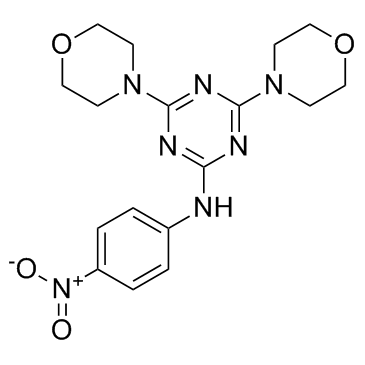326914-06-1
| Name | 4,6-Di(4-morpholinyl)-N-(4-nitrophenyl)-1,3,5-triazin-2-amine |
|---|---|
| Synonyms |
4,6-Di(4-morpholinyl)-N-(4-nitrophenyl)-1,3,5-triazin-2-amine
1,3,5-Triazin-2-amine, 4,6-di-4-morpholinyl-N-(4-nitrophenyl)- 4,6-di(morpholin-4-yl)-N-(4-nitrophenyl)-1,3,5-triazin-2-amine MHY1485 |
| Description | MHY1485 is a cell-permeable mTOR activator. MHY1485 has an inhibitory effect on the autophagic process by inhibition of fusion between autophagosomes and lysosomes. |
|---|---|
| Related Catalog | |
| Target |
mTORC1 mTORC2 Autophagy |
| In Vitro | MHY1485 induces mTOR activity, which is another regulator of autophagy. MHY1485 markedly increases the LC3II/LC3I ratio dose-dependently and time-dependently[1]. An mTOR activator MHY1485 stimulates mTOR, S6K1 and rpS6 phosphorylation. Treatment with MHY1485 increases phospho-mTOR levels without affecting total mTOR content. MHY1485 treatment also increases the phosphorylation of downstream S6K1 and rpS6 proteins without affecting total S6K1 and rpS6 levels[2]. An mTOR activator, MHY1485, also abolishes the inhibitory effect of liraglutide on osteoblastic differentiation, and results in p-mTOR and TGF-β downregulation, but does not attenuate the liraglutide-induced increase in p-AMPK protein expression levels. Co-treatment with 4 nM Liraglutide and 1 µM MHY1485, an mTOR activator, results in protein expression levels of Alp, OC, p-mTOR and TGF-β and matrix mineralization comparable to those of positive control cells cells[3]. MHY1485 treatment increases ribosomal protein S6 kinase (S6K) and eukaryotic translation initiation factor 4E-binding protein 1 (4E-BP1) phosphorylation, which are downstream targets of mTOR complex 1 (mTORC1), but decreases phosphorylation of Akt on mTOR complex 2 (mTORC2) target site serine 473[4]. |
| Kinase Assay | Ovaries from mice at day10 of age are treated with 10 μM MHY1485 for 3h and proteins are extracted using M-PER Mammalian Protein Extraction Reagent containing a protease inhibitor cocktail. Protein concentrations in supernatants are determined by the bicinchoninic acid method. Equal amounts of protein lysates are loaded on 4-12% NuPAGE Bis-Tris gels in MOPS buffer and transferred to 0.45 μM pore nitrocellulose membranes[2]. |
| Cell Assay | MC3T3-E1 cells are maintained in Dulbecco's modified Eagle's medium (DMEM) supplemented with 10% fetal bovine serum (FBS), 100 U/mL penicillin and 100 mg/mL streptomycin at 37°C in a humidified atmosphere of 5% CO2. Having reached 70% confluence, the culture medium is switched to commercial osteogenic differentiation medium. MC3T3-E1 cells are cultured in the osteogenic differentiation medium for 14 days, following by culture in DMEM supplemented with varying concentrations of liraglutide (catalog no. HY-P0014; MedChem Express) for a further 14 days. MC3T3-E1 cells treated with 4 nM liraglutide are cultured in the presence or absence of Compound C or MHY1485. MC3T3-E1 cells maintained in DMEM for 28 days in the absence of any treatment are used as the negative control (NC); cells cultured in commercial osteogenic differentiation medium for 14 days and in DMEM without liraglutide for an additional 14 days are used as the positive control (PC)[3]. |
| References |
| Density | 1.4±0.1 g/cm3 |
|---|---|
| Boiling Point | 643.3±65.0 °C at 760 mmHg |
| Melting Point | 259°C |
| Molecular Formula | C17H21N7O4 |
| Molecular Weight | 387.393 |
| Flash Point | 342.9±34.3 °C |
| Exact Mass | 387.165497 |
| LogP | -0.98 |
| Appearance | white to beige |
| Vapour Pressure | 0.0±1.9 mmHg at 25°C |
| Index of Refraction | 1.652 |
| Storage condition | 2-8°C |
| Water Solubility | DMSO: soluble2mg/mL, clear (warmed) |
| RIDADR | NONH for all modes of transport |
|---|
